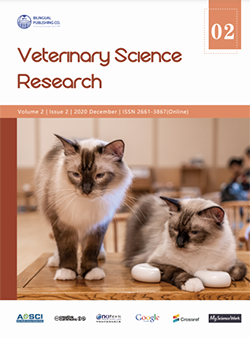Protective Properties in Hymenaea martiana Hayne against Multi-drug-resistant Staphylococcus aureus
DOI:
https://doi.org/10.30564/vsr.v2i2.2528Abstract
Antibiotic resistance represents a widespread problem in milk production. The identification of compounds for a topically applied ointment used in mastitis therapy remains elusive. Compounds from the genus Hymenaea can be administered in cases of multi-drug-resistant Staphylococcus aureus infection for ruminant species, but the protective properties are not well known. Wi this research the aim is verify the protective effects of H. martiana against S. aureus infection in bovine mammary epithelial cell line (MAC-T) and to obtain an antioxidant profile evaluation in vitro. The MAC-T cells were challenged with S. aureus after being exposed to the extract of the H. martiana in the protective assay. For the verification of the viability of the MAC-T cells, the MTT assay was performed, and was used dilutions of the plant extract, starting at 2.5%. The extract of H. martiana was evaluated for antioxidant aspect in different dilutions by FRAP, ORAC and DPPH. A variety of flavonoids (quercetin, luteolin, etc.) have been identified as the main components by using mass spectrometry, reinforcing our in vitro findings that flavonoids, especially quercetin, have a medicinal profile capable of killing mastitis-causing bacteria. An excellent antioxidant pattern was observed in the 2.5% solution; however, membrane integrity in MAC-T cells was compromised. Those findings suggest low dilutions of H. martiana extract has a desirable protective effect from S. aureus pathogenesis. Our in vitro studies can be gleaned upon for further in vivo studies.
Keywords:
Dairy animal, Fitoterapic, Hymenaea gender, Cell activity, MastitisReferences
[1] Dimech GS, Soares LAL, Ferreira MA, et al. Phytochemical And Antibacterial Investigations Of The Extracts And Fractions From The Stem Bark Of Hymenaea Stigonocarpa Mart. Ex Hayne And Effect On Ultrastructure Of Staphylococcus Aureus Induced By Hydroalcoholic Extract. The Scientific World Journal, 2013, 1-8.
[2] Silva MEGS, Guimarães AL, Oliveira AP, et al. HPLC-DAD analysis and antioxidant activity of Hymenaea martiana Hayne (Fabaceae). Journal of Chemicaland Pharmaceutical Research, 2012, 4: 1160-1166.
[3] Peixoto RM, Araujo RMP, Peixoto LJS, et al. Treatment Of Goat Mastitis Experimentally Induced By Staphylococcus Aureus A Formulation Containing Hymenaea Martiana Extract. Small Ruminant Research, 2015, 130: 29-235.
[4] Leitão F, Leitão SG, Almeida MZ, et al. Medicinal plants from open-air markets in the State of Rio de Janeiro, Brazil as a potential source of new antimycobacterial agents. Journal of Ethnopharmacology, 2013, 149: 513-521.
[5] Stagos D, Portesis N, Spanou C, et al. Correlation of total polyphenolic content with antioxidant and antibacterial activity of 24 extracts from Greek domestic Lamiaceae species. Food and Chemical Toxicology, 2012, 50: 4115-4124.
[6] Retta D, Dellacassa E, Villamil J, et al. Marcela, a promising medicinal and aromatic plant from Latin America: A review. Industrial Crops and Products, 2012, 38: 27-38.
[7] Yao X, Zhu L, Chen Y, et al. In vivo and in vitro antioxidant activity and α-glucosidase, α-amylase inhibitory effects of flavonoids from Cichorium glandulosum seeds. Food Chemistry, 2013, 139: 59-66.
[8] Blois MS. Antioxidant determinations by the use of a stable free radical. Nature, 1958, 181: 1199-1200.
[9] Vukovic NL, Obradovic AD, Vukic MD, et al. Cytotoxic, proapoptotic and antioxidative potential of flavonoids isolated from propolis against colon (HCT116) and breast (MDA-MB-231) cancer cell lines. Food Research International, 2018, 106: 71-80.
[10] Almeida RA, Dego OK, Headrick SI, et al. Role of Streptococcus uberis adhesion molecule in the pathogenesis of Streptococcus uberis mastitis. Veterinary Microbiology, 2015, 179: 332-335.
[11] Barros M, Perciano PG, Santos MH, et al. Antibacterial Activity of 7-Epiclusianone and Its Novel Copper Metal Complex on Streptococcus spp. Isolated from Bovine Mastitis and Their Cytotoxicity in MAC-T Cells. Molecules, 2017, 22: 823.
[12] Dunne WMJ. Bacterial Adhesion: Seen Any Good Biofilms Lately? Clinical Microbiology Reviews, 2002, 15: 155-166.
[13] Li, J; Yao, C; Han, J. et al. Quercetin, inflammation and immunity. Nutrients, 2016, 8: 167.
[14] Zhang P, Mak JCW, Man RYK, et al. Flavonoids reduces lipopolysaccharide-induced release of inflammatory mediators in human bronchial epithelial cells: Structure-activity relationship, European Journal of Pharmacology, 2019, 865.
Downloads
Issue
Article Type
License
Copyright and Licensing
The authors shall retain the copyright of their work but allow the Publisher to publish, copy, distribute, and convey the work.
Veterinary Science Research publishes accepted manuscripts under Creative Commons Attribution-NonCommercial 4.0 International License (CC BY-NC 4.0). Authors who submit their papers for publication by Veterinary Science Research agree to have the CC BY-NC 4.0 license applied to their work, and that anyone is allowed to reuse the article or part of it free of charge for non-commercial use. As long as you follow the license terms and original source is properly cited, anyone may copy, redistribute the material in any medium or format, remix, transform, and build upon the material.
License Policy for Reuse of Third-Party Materials
If a manuscript submitted to the journal contains the materials which are held in copyright by a third-party, authors are responsible for obtaining permissions from the copyright holder to reuse or republish any previously published figures, illustrations, charts, tables, photographs, and text excerpts, etc. When submitting a manuscript, official written proof of permission must be provided and clearly stated in the cover letter.
The editorial office of the journal has the right to reject/retract articles that reuse third-party materials without permission.
Journal Policies on Data Sharing
We encourage authors to share articles published in our journal to other data platforms, but only if it is noted that it has been published in this journal.




 Dielson da Silva Vieira
Dielson da Silva Vieira

